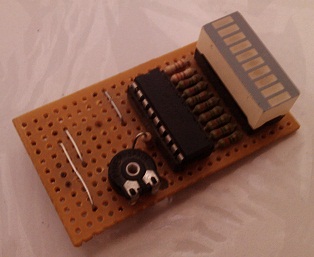
|
This is by far the simplest VUmeter you can build. It is based on a single chip. A volume unit (VU) meter or standard volume indicator is a device for displaying the level of any voltage signal source (which is usually a sound signal).
Connect the module to the output of any amplifier (or preamplifier) and set the trimmer where all LEDs are lighting, when the volume of the amp is at maximum (or at least at that point, where you want all LEDs to light). |
LM3915 is a very powerful and easy to find chip. It's a monolithic integrated circuit that senses analog voltage levels providing a logarithmic 3 dB/step analog display. With it, you can drive LEDs, LCDs or even VFDs (Vacuum Fluorescent Displays).
In this circuit we use it as a VUmeter, driving 10 LEDs. Each time a new LED is lighting when the input voltage is 1.41 times the voltage, where the previous LED started to light. This is exactly the point where the voltage is 3dB higher than the previous one.
Here is the schematic diagram of the simple VUmeter.
Note: The schematic is upside down, meaning the first LED (that flashes at lower dBs) is the one connected to pin 1 of LM3915.
Attention: Make sure you solder the 100nF capacitor as close to LM3915 power supply pins as possible. The optional electrolytic capacitor is required only if leads to the LED supply are 15cm (about 6 inches) or longer. All 220Ω resistors are used to limit LM3915 power dissipation and aren't optional.
|
Don't worry when the input voltage (signal) becomes negative.
LM3915 can handle negative (and positive) voltages up to
35V without damaging the chip.
You can use a precision full-wave rectification circuit at the input, if you want a more accurate reading. |
Pictures
In the following pictures you see the circuit built on a piece of Veroboard.




No comments:
Post a Comment